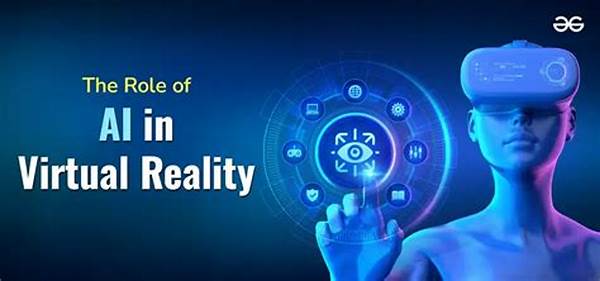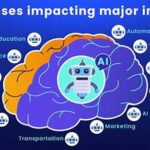Virtual reality (VR) is no longer the stuff of science fiction. It’s here, and it’s transforming how we experience everything from gaming to training simulations. But behind the scenes of this revolution is a certain hero: Artificial Intelligence (AI). The relationship between AI and VR is akin to an inexplicable bond, deepening the interactive experience and tailoring content to an individual’s needs. With AI’s rapid advancements, the role of AI in virtual reality content evolves into a force of nature worthy of exploration, exciting gamers, educators, and marketers alike.
Read More : Best Ai Tools For Architects And Engineers
Artificial Intelligence in VR doesn’t just automate processes—it personalizes, optimizes, and creates in ways previously unimaginable. Imagine a gaming character that learns and adapts to your behavior, or a virtual store that understands your unique shopping preferences. That’s AI at work, and it’s only just scratching the surface. New techniques in deep learning and data algorithms mean that VR environments are more realistic and immersive than ever. The capabilities range from creating realistic avatars that blink and breathe like real people, to entire worlds that feel alive, with weather systems and ambient sounds tailored to the user’s preferences. This dynamic content means that each experience is unique, ensuring that you never step into the exact same virtual world twice.
In the entertainment industry, the role of AI in virtual reality content is groundbreaking. Film directors can create interactive movies where viewers determine the outcome based on their choices. In education, it enables truly personalized learning experiences—students can explore ancient civilizations or complex scientific phenomena in ways never possible in a classroom. The healthcare sector also benefits immensely, with realistic training environments that simulate surgeries and allow for repeated practice without risk to patients. In essence, AI molds VR content into an instrument ripe for innovation, ensuring industries stay ahead of the curve.
Embracing AI’s Future in VR
Our journey through the potential of AI in virtual reality content unveils a tapestry rich with promise and innovation. As these technologies become increasingly symbiotic, the real question is: Are you ready to embrace this future? Whether you’re a creator, a consumer, or an educator, the doors opened by AI in VR are yours to explore. Dive in, and be part of the wave that’s reshaping experiences as we know them. The result? A more dynamic, inclusive, and vibrant virtual world where the only limit is your imagination.
—
Introducing AI-Driven Virtual Reality
Virtual reality has stepped off the pages of sci-fi novels and into our everyday lives, propelled to new heights by the inexorable march of technology and innovation. But it’s AI—Artificial Intelligence—that has added layers of depth and complexity to VR, transforming static, linear content into living, breathing experiences. The role of AI in virtual reality content has moved far beyond making characters move or providing basic interactivity. It now delves into personalizing entire experiences and anticipating user needs even before they emerge.
When you first don a VR headset and step into a virtual world, there’s an air of awe and wonder that hooks you almost immediately. But as the novelty wears off, it’s the intelligence within the system—powered by AI—that keeps the experience fresh and engaging. AI operates in the background, analyzing user behavior and preferences, and adapting the content dynamically to suit the individual. This adaptive nature means that every time you log in, you’re in for something tailor-made just for you.
How AI Enhances VR Experiences
Rather than being bound by pre-set paths or outcomes, AI offers limitless possibilities. Imagine a museum tour where the guide adapts the narrative based on questions you ask, or an art lesson that evolves based on your learning speed. The role of AI in virtual reality content is about weaving an experience that feels less like a program and more like life itself.
The Intersection of Creativity and Logic
There’s a delightful union between artistic creativity and logical algorithms in the AI-VR space. When these two forces combine, the results can be magical: experiences that are both deeply imaginative and highly efficient. Whether you’re delving into the lush landscapes of a mythical world or negotiating a tough business situation in a simulated environment, AI enriches the VR experience with an adaptive intelligence that feels both creative and intuitive.
The Future of AI in Virtual Reality
As AI technologies advance, the boundaries of what is possible within virtual reality will continue to expand. We stand on the cusp of a new era where VR isn’t just about detaching from reality but enhancing it in ways we never thought possible. Industries such as retail, healthcare, and even real estate are harnessing these capabilities to create environments that are as functional as they are breathtaking. The role of AI in virtual reality content is pivotal, crafting a future where experiences are as individual as the people who engage with them.
—
Goals for AI in VR Content
In exploring the role of AI in virtual reality content, several goals underscore the progress and intent of these innovative ventures. These objectives guide how AI is applied, pushing the boundaries of what VR can achieve.
Objectives of AI-Driven VR Content
The overarching goal for AI in virtual reality content is not only to entertain but educate, train, and transform industries. As research advances and technology becomes more accessible, these objectives remain grounded in a desire to enhance human experiences through simulated realities. By doing so, VR no longer serves merely as a tool for escapism but becomes an integrated aspect of everyday life, a realm where creativity, efficiency, and artificial intelligence collaborate seamlessly.
The Expansion of AI-Enhanced VR
The future holds endless possibilities for AI in virtual reality. The focus is on continuously refining these goals to meet the ever-evolving demands of users and industries. It’s an ongoing mission to push past the boundaries of imagination, moving toward a world where virtual experiences are indistinguishable from physical ones. Whether through entertainment, education, or commerce, the task remains clear: employ AI to create VR content that is as impactful and diverse as a user’s own imaginative potential.
—
AI in VR: Transforming Experiences
Artificial Intelligence stands as the backbone of many transformative experiences in virtual reality, acting as both the catalyst for change and the canvas on which dynamic virtual worlds are painted. Understanding the role of AI in virtual reality content requires examining how these two technologies interweave, creating layers of immersion that rival reality itself.
Personalization at Its Finest
Gone are the days when VR experiences came with set, unchanging narratives. AI’s strength lies in its knack for learning and evolving, allowing users to experience personalized virtual adventures that reflect their individual preferences and quirks. This kind of personalization is not just a luxury—it’s becoming a standard in modern VR design, and AI is at the core of this shift.
Building Realistic Worlds
With AI, the crafting of realistic and responsive virtual worlds is no longer limited by manual programming. Natural language processing, machine learning, and computer vision empower VR systems to convincingly simulate complex human behaviors, weather patterns, and even economic systems within a virtual space. The role of this advanced AI in virtual reality content is to create an ever-changing, but intuitively understandable universe.
Enhancing Interaction and Realism
The dynamic interaction made possible by AI amplifies the sense of realism in VR. Characters that react to user conversations in a human-like manner, or environments that change based on user choices, create compelling narratives and interactions that feel organic and spontaneous. Whether it’s for gaming or social interaction, the virtual becomes more lifelike as AI fine-tunes these experiences.
Bridging the Gap With New Realities
As AI-driven VR technology progresses, the lines between virtual and reality blur further, presenting exciting opportunities across industries. In education, students can travel back in time to witness historical events or explore distant planets. For healthcare, AI-modulated environments offer precise simulations for training purposes, reducing risk and improving accuracy in real-world applications.
Pushing Boundaries: AI-Driven Creativity
Every leap in VR capability is driven by AI’s growing capacity to think in abstract and creative terms. Some of the best examples are seen in art and storytelling—fields traditionally reliant on human intuition and creativity. AI is no longer just a tool; it is a co-creator, pushing boundaries and allowing VR content creators to achieve unparalleled heights in innovation.
The Road Ahead for AI and VR
Looking forward, the possibilities are as endless as the virtual realms AI helps to build. With continued investment and exploration, AI will drive the next generation of virtual experiences to seamless, exciting heights that connect people worldwide. Whether it’s constructing more nuanced worlds or facilitating meaningful interactions therein, the role of AI in virtual reality content remains paramount as technology continues its relentless march forward.


